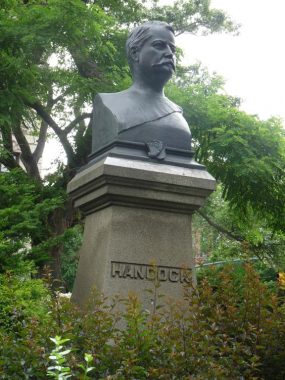At a confluence of roads (West 124th Street, Manhattan and St. Nicholas Avenues, and Hancock Place) we find a bust of Winfield Scott Hancock by James Wilson Alexander McDonald, dedicated in 1891. Hancock (1824-1886) served with distinction for the US Army in both the Mexican and War Between the States. Perhaps his greatest triumph came at Gettysburg:
On July 3, Hancock continued in his position on Cemetery Ridge and thus bore the brunt of Pickett’s Charge. During the massive Confederate artillery bombardment that preceded the infantry assault, Hancock was prominent on horseback in reviewing and encouraging his troops. When one of his subordinates protested, “General, the corps commander ought not to risk his life that way,” Hancock is said to have replied, “There are times when a corps commander’s life does not count.” During the infantry assault, his old friend, now Brig. Gen. Lewis A. Armistead, leading a brigade in Maj. Gen. George Pickett’s division, was wounded and died two days later. Hancock could not meet with his friend because he had just been wounded himself, a severe injury caused by a bullet striking the pommel of his saddle, entering his inner right thigh along with wood fragments and a large bent nail.
Helped from his horse by aides, and with a tourniquet applied to stanch the bleeding, he removed the saddle nail himself and, mistaking its source, remarked wryly, “They must be hard up for ammunition when they throw such shot as that.” News of Armistead’s mortal wounding was brought to Hancock by a member of his staff, Captain Henry H. Bingham. Despite his pain, Hancock refused evacuation to the rear until the battle was resolved. He had been an inspiration for his troops throughout the three-day battle. Hancock later received the thanks of the U.S. Congress for “… his gallant, meritorious and conspicuous share in that great and decisive victory.”wikipedia
Hancock was named for General Winfield Scott (1786-1866). A Democrat, he lost by the narrow margin of 7,000 votes to James Garfield for the presidency in 1880. Memorial statues to the general can also be found in Market Square (Pennsylvania Ave. and 7th Street) in Washington, DC, in Fairmount Park in Philadelphia, and Cemetery Hill at Gettysburg, PA.
Check out the ForgottenBook, take a look at the gift shop, and as always, “comment…as you see fit.”
7/29/20
